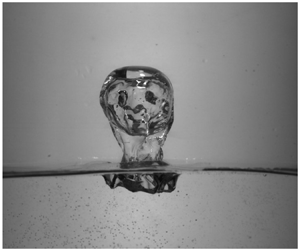Published online by Cambridge University Press: 29 October 2024

Toroidal bubbles (TBs) represent cases of vortex rings with a gas–liquid interface where a gas vortex ring is encased within a liquid vortex ring, and can serve as effective media for mass conveyance, process mixing, noise reduction and reaction regulation. In this study, we carry out a systematic study on the interaction between a TB and a free surface. According to the high-speed photographic images from the experiments, we identify strong and weak interactions in terms of the normalized maximum free surface deformation  $h_{max}^*$. Then, we perform numerical simulations based on the volume of fluid (VOF) method in the OpenFOAM platform. Based on both the experimental and the numerical results, we conclude that the Froude number,
$h_{max}^*$. Then, we perform numerical simulations based on the volume of fluid (VOF) method in the OpenFOAM platform. Based on both the experimental and the numerical results, we conclude that the Froude number,  $Fr$, determines the main characteristics during the interaction process. The TB–free surface interaction is essentially the interaction between the liquid vortex ring enveloping the TB and the free surface, supplemented by the TB's complex behaviour. Next, we establish the scaling law of
$Fr$, determines the main characteristics during the interaction process. The TB–free surface interaction is essentially the interaction between the liquid vortex ring enveloping the TB and the free surface, supplemented by the TB's complex behaviour. Next, we establish the scaling law of  $h_{max}^*$ based on the energy balance condition. Based on this, we provide the critical
$h_{max}^*$ based on the energy balance condition. Based on this, we provide the critical  $Fr$ and the slenderness of the TB,
$Fr$ and the slenderness of the TB,  $\eta$, for identifying the strong and weak interactions, and a parametric plot of the interactions in terms of
$\eta$, for identifying the strong and weak interactions, and a parametric plot of the interactions in terms of  $Fr$ and
$Fr$ and  $\eta$.
$\eta$.